Purple basil varieties are known for their strong aroma and rich flavor. Among them, the 'Ararat' stands out as a favorite among many gardeners. Let’s explore the characteristics of the 'Ararat' vegetable basil, its advantages, differences from other varieties, and the cultivation process from seeds.
Table of contents
Features of the Variety
The 'Ararat' basil was developed in Central Europe by a leading agrotech company and was officially registered in 2004. It is recommended for cultivation across various European climates.
This purple basil has a deep, spicy flavor and a complex, captivating aroma.
Its widespread popularity is due to several advantages:
- Easy to grow;
- Low maintenance;
- Versatile in culinary use;
- Rich, intense flavor thanks to high essential oil content, with unique notes of clove, allspice, and anise;
- Excellent for ornamental gardening due to its decorative bush structure;
- Great for drying (retains its strong aroma);
- High yield.
Below is a photo of 'Ararat' basil.
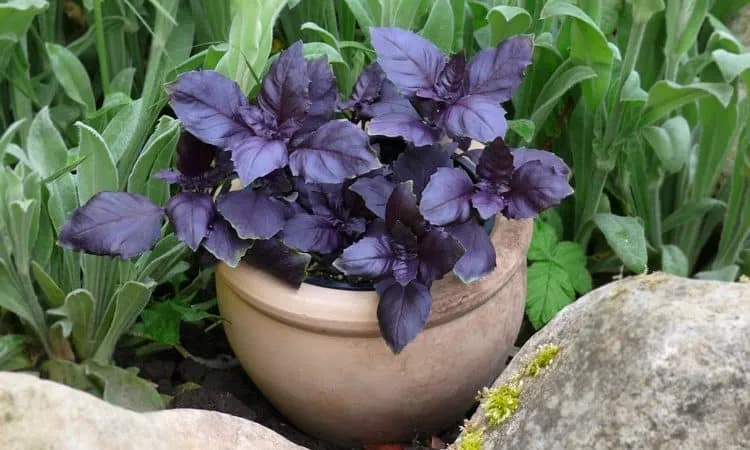
Characteristics and Description
The 'Ararat' basil forms an upright, semi-spreading bush up to 60 cm tall. The leaves are ovate with serrated edges, green-purple in color, medium-sized, with lilac flowers.
The plant begins flowering around 71 days after germination. By this stage, it has accumulated enough nutrients and essential oils, making it ready for harvest. This variety is considered mid-season.
The yield is approximately 2-2.2 kg of greens per square meter.
Chemical Composition
The plant is rich in vitamins, minerals, and complex organic compounds.
Per 100 g of leaves, it contains:
- Vitamin A – 264 μg;

- Vitamin C – 18 mg;
- B Vitamins – 0.542 mg;
- Vitamin K – 414.8 μg;
- Vitamin PP – 0.902 mg;
- Vitamin E – 0.8 mg;
- Carotene – 3.142 mg;
- Mono- and polysaccharides – 0.3 g;
- Saturated fatty acids – 0.04 g;
- Choline – 11.4 mg;
- Iron – 3.17 mg;
- Copper – 0.04 mg;
- Zinc – 0.81 mg;
- Manganese – 1.148 mg;
- Magnesium – 64 mg;
- Calcium – 177 mg;
- Potassium – 295 mg;
- Selenium – 0.3 μg;
- Sodium – 4 mg;
- Phosphorus – 56 mg;
- Dietary fiber – 1.65 g.
The basil also contains essential oils such as:
- Camphor;
- Saponin;
- Ocimene;
- Methyl chavicol.
The combination of these oils defines its distinctive aroma.
The caloric value of 'Ararat' basil is 25 kcal per 100 g.
Plant Resilience
Despite being a heat-loving plant, 'Ararat' basil is more resilient to adverse conditions compared to other varieties.
Basil thrives in full sunlight and does not tolerate waterlogging. The soil should always remain slightly moist.
This plant prefers warmth, with optimal growth temperatures between +18…+27°C. Lower temperatures stunt its growth, and frost will kill it outright.
The 'Ararat' variety is resistant to diseases but may develop fungal infections (gray mold, black stem rot, or fusarium) under unfavorable weather conditions.
Uses of the 'Ararat' Variety
Purple basil leaves contain higher levels of essential oils compared to green varieties, giving them a more intense flavor with hints of allspice, clove, and anise.
'Ararat' basil is used in: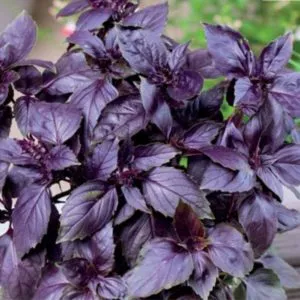
- Meat, fish, legume, and tomato dishes;
- Vegetable pickling;
- Jam-making, soups, and sauces;
- Tea and compote infusions.
The leaves can be dried, frozen, or preserved in salt for winter use.
Due to its rich chemical composition, basil has long been used not only in cooking but also in medicine. Applications include:
- Aromatherapy (as an aphrodisiac, calming nerves and relieving headaches);
- Wound treatment;
- Cosmetics (improves skin and nail health).
Purple basil also offers protection against radiation. Oil infused with 'Ararat' basil makes an excellent relaxant when added to bathwater.
Note: Consult a healthcare professional before using basil for medicinal purposes.
Growing Techniques
Basil can be grown in greenhouses, on windowsills, or in open fields.
Important: Avoid planting basil in the same spot for more than three consecutive years to prevent fusarium infection in neighboring plants.
Good companion plants for basil include tomatoes, bell peppers, potatoes, and legumes.
Optimal Conditions
Plant basil in a sunny, draft-free location. For vibrant purple leaves, ample sunlight is essential.
The ideal air temperature for growth is above +18°C.
Basil prefers moist, humus-rich soil with good drainage.
Sowing Time and Guidelines
Seedling trays should be placed in a warm, sunny spot. Seeds are sown two months before transplanting outdoors. Place 3-4 seeds per hole.
Transplant seedlings (25 days old) into open ground after the last frost, preferably in the evening on a calm day. Pre-treat the soil with a fungicide to prevent fungal infections.
Dig 10 cm deep holes, spaced 20 cm apart, water generously, place seedlings with their root ball, cover with soil, lightly press, and water again. Apply nitrogen-rich fertilizer two weeks after planting.
Tip: Fertilization is key to a bountiful harvest.
Ongoing Care
Regular care ensures optimal growth. Timely watering, fertilization, and weeding guarantee a good yield.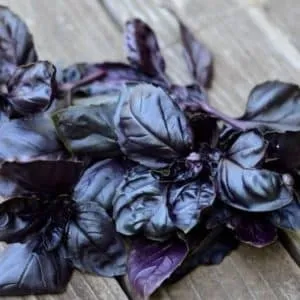
'Ararat' basil requires consistent watering. Avoid waterlogging—well-drained soil is crucial. Overwatering leads to fungal diseases, while underwatering results in smaller, less flavorful leaves.
Water at the base in the morning using room-temperature water. The soil should stay slightly moist.
Loosen the soil and remove weeds weekly after watering.
Fertilize two weeks after planting, then monthly until flowering begins. Use nitrogen-based fertilizers.
Pinch the plant to encourage bushiness—first when it develops 6-8 leaves.
Under poor conditions, 'Ararat' basil may suffer from:
- Gray Mold: Develops in high humidity, especially in greenhouses. Gray spots and mold appear, killing the plant.
- Black Stem Rot: Caused by overwatering and acidic soil, this fungus attacks the stem base.
- Fusarium: A soil-borne fungus that dries the plant from the top down. Crop rotation prevents it.
Fungicides are used for treatment.
Warning: Apply fungicides and herbicides at least 20 days before harvest.
Common pests include aphids and spider mites. Natural remedies (onion peel and soap solution) or store-bought insecticides can help.
Growing from Seeds vs. Seedlings
The difference between direct seeding and transplanting lies in harvest timing.
Open Field Cultivation
In temperate European climates, transplanting seedlings ensures an earlier harvest due to unpredictable spring temperatures.
Direct seeding in open ground is done after the last frost (early June), delaying harvest.
In warmer regions, successive sowings allow multiple harvests per season.
Greenhouse Cultivation
Greenhouses allow year-round growth at +20…+25°C. Key requirement: antifungal soil treatment with fungicides.
Pre-soak seeds in warm water for a week, then in a fungicide solution for 2 hours.
Sow seeds 0.5-1 cm deep in pots with drainage. Cover with plastic to retain humidity. Transplant seedlings at the 2-leaf stage.
Indoor Cultivation
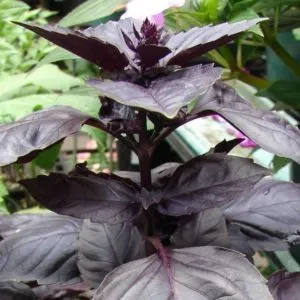
Use well-draining pots with organic-rich soil. Sow seeds 0.5-1 cm deep, cover with film, and thin out at the 2-leaf stage.
Place in a sunny, draft-free spot. Water regularly; use a humidity tray if needed. Fertilize, aerate soil, and pinch stems.
Alternatively, transplant outdoor basil indoors in August for winter harvests.
Gardeners' Reviews of 'Ararat' Purple Basil
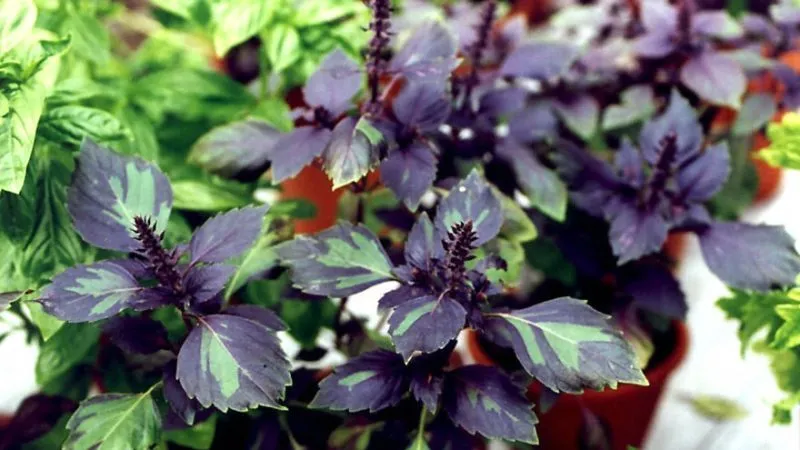
Reviews of 'Ararat' basil are overwhelmingly positive, praising its ease of growth and high yield.
Sophie, France: "I grow 'Ararat' basil every year—first in the greenhouse, then outside. It transplants well. I dry it for winter—it’s a must for meat dishes!"
Anna, Germany: "The aroma stays strong after drying, unlike other varieties. Germination is excellent, whether in a greenhouse or outdoors."
Elena, Spain: "I always choose 'Ararat'—it thrives in my garden and on my balcony. I add it to strawberry jam, tea, and countless recipes. Simply amazing!"
Conclusion
The 'Ararat' purple basil stands out for its high germination rate, productivity, and disease resistance when properly cared for. Rich in vitamins, minerals, and essential oils, it is widely used in cooking and cosmetics.
With the right temperature, light, and watering, this aromatic herb can flourish not only in gardens and greenhouses but also on windowsills.







